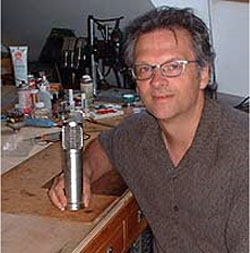
BB: So what’s involved in the process? How do you make one vintage mic sound like another?
KH: First, I would need to have the one you want to match it to. And you can never get it 100% exactly the same. If you had machinery that could pick up these things, then—bam!—you would not need me. There are so many subtleties. With some vintage microphones, you will have five or six generations of the capsule alone, with up to 25 sub-suppliers, some with shoddy tolerances. On any given day, you could have a capsule with front diaphragm from supplier A and back diaphragm from supplier B. So, within reason, I would listen to it, get a rough idea of where we are.
Let’s say you have an Elam that is fairly aggressive, with lots of information in the upper mids, maybe grating on your ears a little bit, but maybe dropping down some in the low mids and very top end. I first call back the customer and say, this is what I hear. Is this what you want? Sometimes they say, “Well, yes, but I would also like more warmth and transparency!” So we get a conversation going back and forth. Once I know what they really want, then I first look at the basic components and see if they are the same.
For example, Elams had used two different tubes, so they are not all the same circuitry. Then I would look at the capsule vintage. Is one the later version with the deep dish? I may have to go to my stash and find another one. I may end up assembling the whole capsule, which is a total pain in the ass. It is weeks of work. All I can do with it, is go back and forth and use my experience. And like a wine taster, I can only do so much in a day. I typically do my listening mornings and mid-days, do assembly in the afternoon, and about seven in the evening I go back to work and start listening. I use my voice as my reference signal.
BB: Only your voice?
KH: Yes, only my voice. I can translate it into any situation, because I’ve used it so long. For example, I can say, “eins, zwei, drei, vier” ..say “drei”, you have an explosive, a sine wave, a guttural at the end, and it’s all fairly complex. With “zwei you have an implosive and a sibilant up front…it’s complex enough so I know if what I say or sing is processed correctly by the microphone, or is something not getting through. When I can’t listen any more, I stop and do something else.
Then sometimes I may come back the next day and say, “This is terrible, what I did yesterday. I must not have been thinking clearly.” This is a multi-step process, going back and forth until I finally say, This is it! Let’s not go any further, let’s not turn any more torquing screws, this is perfect. I put it together, let it cook for two days, and it goes out to the customer.
BB: I assume you’ve been using the same preamplifier and headphones for a long time to have a continuing reference.
KH: Forever. The same Sennheiser headphones, these old HD-414s. I took everything out and reworked them, but I’ve been using them since age 16. They are my second pair of ears. They are so good in the midrange. They have good highs and lows, too, but my experience is that if you get the midrange right, the other stuff falls into place. The midrange gives information about resolution, about detail, about phase shift, all of this happens in the midrange.
BB: Midrange defined as what?
KH: Oh, I suppose about 500 Hz to 5 kHz. But I have measured the Sennheisers, and they go up to 18K still. I restore them every year or two, clean out all the crud. Because I take the foam muffs off, I get all the bass, but they do get some dirt in there.
